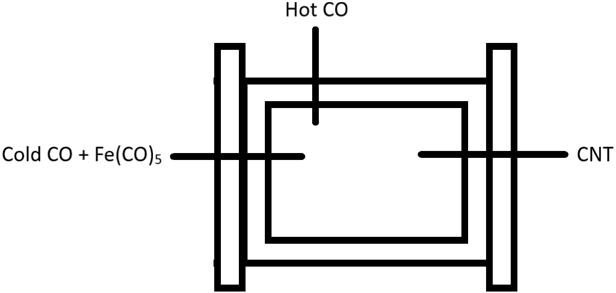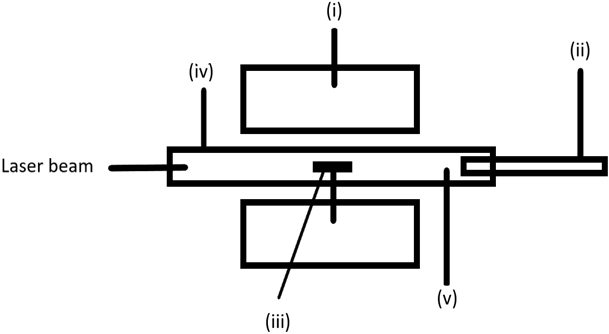This set of Nanotechnology Multiple Choice Questions & Answers (MCQs) focuses on “Carbon Nanotubes”.
1. Choose the correct range of growth temperature of CNT in CVD.
a) 500°C-700°C
b) 700°C-900°C
c) 900°C-1200°C
d) 500°C-1200°C
View Answer
Explanation: The CVD method involves the decomposition of a hydrocarbon such as methane, ethane etc., at a very high temperature range of (500°C – 1200°C). As the decomposition progresses, carbon atoms released are collected on the cooler substrate that contain various catalysts such as iron, cobalt and nickel. Nanotubes grow at the sites of these metal catalysts into very long and well aligned tubes.
2. What method of CNT production does the given diagram represent?

a) Laser Ablation
b) Plasma arc
c) Liquid electrolysis
d) HiPCO
View Answer
Explanation: HiPCO method of CNT production is carried out at high pressures of about (30-50 atm). Here, iron pentacarbonyl reacts with carbon monoxide, providing it with nucleation and growing sites for CNTs.
3. Select the correct matched pair from the following options.
a) CVD = Ni catalyst; Liquid electrolysis = Molten nitrides
b) n-hexane pyrolysis = Microtubes; Laser Ablation = Double pulsed laser
c) Plasma torch = Non-ionized gas; HiPCO = Carbon dioxide gas
d) Arc discharge = A/C current; Super-growth CVD = Water assisted CVD
View Answer
Explanation: n-hexane pyrolysis method of CNT production forms macroscopic bundles called microtubes that have its length in centimeters. Laser Ablation method, on the other hand, makes use of double pulsed laser to produce high quality carbon nanotubes.
4. What is the full form of HiPCO method used for CNT production?
a) High – Potential Carbon Nanotube
b) High – Pressure Carbon Monoxide
c) High – Potential Carbon Monoxide
d) High – Pressure Carbon Nanotube
View Answer
Explanation: High – Pressure Carbon Monoxide (HiPCO) is a method of CNT production achieved under high pressure of about (30-50) atm. It was established to produce single walled carbon nanotubes from the gas phase reaction of iron pentacarbonyl [Fe(CO)5] with high pressure carbon monoxide gas.
5. What is the major disadvantage in Arc Discharge method of CNT production?
a) Very expensive process
b) Lower production rate of nanotubes
c) Little control over alignment of nanotubes
d) Use of highly complicated machineries
View Answer
Explanation: Arc discharge method is one of the primary methods of CNT synthesis. It produces enormous amounts of CNTs but the major disadvantage it has is that there is less control over the alignment (i.e., chirality) of the produced nanotubes. This is very important for their characterization and role. Moreover, the nanotubes produced during this method need to be further purified because of the metallic catalyst involved in the reaction.
6. Select from the following options the most efficient method of CNT production.
a) Arc discharge
b) Laser Ablation
c) Liquid electrolysis
d) CVD
View Answer
Explanation: CVD method that incorporates catalyst-assisted thermal decomposition of hydrocarbons is the most efficient and popular method of CNT synthesis. It is an economical and scalable technique for mass production of CNT. Moreover, this method forms the purest CNTs of standard structural quality.
7. Which was the first method used for the synthesis of CNTs?
a) Arc discharge
b) HiPCO
c) CVD
d) Liquid electrolysis method
View Answer
Explanation: Arc discharge method is the earliest method to produce CNTs in reasonable quantities. This method involves the application of an electric current across graphite electrodes that are placed in an inert, high atmosphere temperature (~ 4000°C).
8. Identify the effect occurring during CNT synthesis that helps preserve the open edge of the tubes and prevents it from closing.
a) Inductive effect
b) Scooter effect
c) Magnus effect
d) Kappa effect
View Answer
Explanation: Scooter effect suggests that metal atoms acting as catalysts attach to the dangling bonds at open edges of the tubes. Whenever carbon atoms begin to attach and form rings, the metallic atom scoots around the rim of the tube, absorbing carbon atoms. Thus, they preserve the open edge of the tube and prevent it from closing.
9. The VANTAs, formed using the super – growth CVD process, originate from what kind of effect?
a) Scooter effect
b) El-nino effect
c) Zipping effect
d) Decoy effect
View Answer
Explanation: The VANTAs originate from a zipping effect when they are immersed in a solvent and dried. The surface tension of the solvent and the Van der Waals forces between carbon nanotubes give rise to this effect. Zipping effect is responsible for aligning the nanotubes in a dense material that can be turned into sheets and bars.
10. Identify an issue of the n-hexane pyrolysis method for CNT production from the following options.
a) Poor elasticity of nanotubes formed
b) Small sized SWCNTs produced
c) Microtubes are formed having length in centimeters
d) Nanotubes can be grown on various surfaces
View Answer
Explanation: n-hexane pyrolysis process synthesizes large, long, single walled carbon nanotube bundles in a furnace by pyrolyzing hexane molecules. It produces macroscopic nanotube bundles having length in several centimeters. But, the elasticity of these nanotube bundles is not as great as hoped (i.e., they are quite brittle).
11. Which of the following methods is not used for the synthesis of CNT?
a) Arc-discharge
b) Chemical Vapour Deposition
c) Low-Pressure Carbon Monoxide
d) Laser Ablation
View Answer
Explanation: Carbon nanotubes (CNTs) are fabricated using several procedures. These include Arc-discharge method, Chemical Vapour Deposition (CVD), Laser Ablation method, n-hexane pyrolysis, High-pressure carbon monoxide (HiPCO), Liquid electrolysis method, plasma torch etc. However, CNTs cannot be grown at low pressure.
12. Label the marked parts of the diagram for laser ablation method of CNT production.

a) (ii) = Water cooled Cu collector; (iii) = Graphite target
b) (i) = Quartz tube; (v) = Argon gas
c) (iii) = Furnace; (iv) = Quartz tube
d) (iv) = Graphite target; (v) = Water cooled Cu collector
View Answer
Explanation: In the above diagram for laser ablation method of CNT production the marked parts are;
(i) Furnace; (ii) Water cooled copper collector; (iii) Graphite target; (iv) Quartz tube; (v) Argon gas.
More MCQs on Carbon Nanotubes:
- Carbon Nanotubes MCQ (Set 2)
- Carbon Nanotubes MCQ (Set 3)
- Carbon Nanotubes MCQ (Set 4)
- Carbon Nanotubes MCQ (Set 5)
- Carbon Nanotubes MCQ (Set 6)
Sanfoundry Global Education & Learning Series – Nanotechnology.
To practice all areas of Nanotechnology, here is complete set of 1000+ Multiple Choice Questions and Answers.
If you find a mistake in question / option / answer, kindly take a screenshot and email to [email protected]
